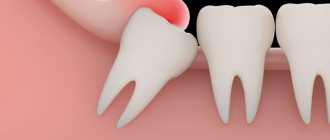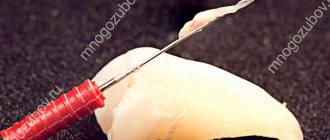A cyst is a benign neoplasm that can cause potential harm to health. Its appearance cannot but be alarming, so it is worth understanding why a cyst appears on the gum and how to treat it.
Content:
- What will happen if left untreated?
- Why does it occur
- Classification 3.1. Root 3.2. Residual 3.3. Follicular 3.4. Teething 3.5. Primordial 3.6. Lateral periodontal 3.7. Calcifying odontogenic
- Symptoms
- How to treat 5.1. Surgical treatment 5.3. Conservative therapy 5.3.1. Depophoresis - an innovative method of conservative treatment
A pathological neoplasm formed in the gum as a result of a protective reaction to infection or injury is called a cyst.
Its appearance is caused by penetration of pathogenic microorganisms through the root canals. As a result, severe inflammation develops. Tissues that are involved in the inflammatory process slowly die. A cavity is formed. Liquid exudate accumulates in it. A cyst in the gum is a way to protect against further spread of the infectious process. A dense capsule appears around the lesion, holding necrotic cells inside. Its dimensions can range from a few millimeters to a couple of centimeters.
If the diameter of a cyst on the gum does not exceed 5 mm, it is called a granuloma. In total, dentists distinguish three stages of inflammation:
- granuloma;
- cystogranuloma;
- cyst.
The sooner the patient seeks medical help, the better. If you postpone treatment until later, you may lose your tooth.
The difficulty is that in the first stages inflammation most often does not manifest itself. But the number of pathogenic microorganisms in the tumor is rapidly increasing. To stop the abnormal process, the body sends immune cells to its source. This negatively affects the functioning of the immune system and leads to its weakening.
Causes of dental cysts in children
Most parents do not seriously care about the health of their children’s teeth until they replace their baby teeth with permanent ones, arguing that the baby teeth will fall out anyway. This opinion is wrong - it is quite possible for a cyst to appear on a child’s baby tooth.
If caries has progressed to pulpitis, and then to periodontitis, then such a tooth becomes a source of infection, and the body, in order to stop its spread, turns on self-defense. To do this, it forms, most often at the root of the tooth, a protective bubble, or granuloma, which then transforms into a jaw cyst.
But not only advanced dental diseases can cause the formation of a tooth root cyst. Any injury, from cracking nuts to a blow to the jaw, can trigger the appearance of a dental cyst in a child. Those parents whose children are young hockey players or boxers need to be especially careful.
Also, if the treatment of pulpitis is poorly carried out, the infection will reach the roots through the canals of the tooth, as a result of which a rare type of dental cyst in children may occur - follicular, which occurs only in 6% of cases. The only thing you can wish for in such circumstances is to approach the choice of clinic and doctor competently and with all seriousness, otherwise your teeth will have to be constantly re-treated.
In addition, there is such a thing as an eruption cyst. It occurs several weeks before the appearance of a new baby or molar tooth. Teething cysts in children can be caused by infection, trauma, caries, or dental abnormalities.
Photo of eruption cyst in children
What will happen if left untreated?
Ignoring the symptoms of the disease leads to dangerous consequences for health. Thus, the patient may encounter:
- destruction of roots, their strong loosening;
- jaw fracture;
- tumor formation;
- purulent abscess;
- periostat;
- osteomyelitis.
The disease can cause the development of sepsis. This is a very serious condition in which the infection enters the blood and quickly spreads throughout the body.
Why does it occur
Among the main causes of pathology:
- advanced caries;
- jaw injuries;
- illiterate root canal treatment;
- overload of individual units as a result of poorly performed prosthetics;
- congenital anomalies of the upper/lower jaw;
- infections of the nasopharynx and oral cavity.
Regardless of the characteristics of the provoking factor, a gum cyst should be treated under the supervision of a dentist. Self-medication for this diagnosis is unacceptable.
Classification
All cysts that occur in the human oral cavity can be divided into the following types:
- root;
- residual;
- follicular;
- teething;
- primordial;
- lateral periodontal;
- calcifying odontogenic.
Let's talk about each of them in more detail.
Root
It is a consequence of granuloma that appears due to periapical inflammation and necrosis. Located in the area of the apical part of the root. The boundaries of such a structure are easily determined. Its size can be from 2 mm to 3 cm. But even with a large diameter, root formation does not lead to a change in bone volume or displacement of the incisor. Only if a secondary inflammatory process is involved, the disease makes itself known through pain and swelling.
When identifying a disease, you need to understand what led to its appearance and take measures to eliminate the provoking factors. Usually the problem can be resolved with endodontic therapy.
Residual
It is also called residual. Appears after removal right in the place where the roots of the torn out unit were previously located. X-ray diagnostics helps determine the presence of a residual structure.
Follicular
It is formed from the tissues of the follicular sac that covers the rudiments. Easily visible in the photo. Often leads to serious damage to premolars and molars.
As a rule, follicular formations quickly increase in size and can spread to adjacent teeth, changing their location and angle of inclination. Traditionally, their treatment involves surgical curettage.
Teething
Appears during the period of eruption of permanent units. Covers the emerging rudiment. May contain blood. Visually resembles edema, swelling. Has a bluish tint.
Sometimes it ruptures spontaneously, spontaneously. Then the person simply notices that the “ball” has disappeared, the liquid has flowed out of it. In rare cases, surgery may have to be performed. During this procedure, the blood sac is opened, and the structures that interfere with further eruption of the molar are excised.
Primordial
Formed on the basis of the tooth germ. Most often diagnosed in the area of the posterior units. This type of formation is prone to recurrence. To cure the primordial structure, it is necessary to curettage the altered tissues.
Lateral periodontal
Rarely encountered in dental practice. It has modest dimensions. Clearly visible on X-ray images. This cavity is called a lateral cavity, since it is fixed to the side of the tooth root.
The tumor can only be removed by curettage. The material obtained during the operation is necessarily sent for histological analysis to ensure that the disease present in the person is benign.
Calcifying odontogenic
Another rare type of cyst. Observed in the lower part of the supporting surface of the jaw. Well visualized on x-rays. There is cloudy contents inside. Its color depends on the degree of calcification.
Immediately after diagnosis, surgical curettage is performed.
Symptoms
The disease manifests itself as a dull pain when eating solid food. A fistula may form on the gum. Patients also complain of:
- swelling of the face;
- swelling;
- increased body temperature;
- weakness, decreased performance;
- high sensitivity to temperature changes;
- increased volume and tenderness of the lymph nodes;
- toothache.
If a tooth looks healthy, but pain occurs when pressing on it, you should definitely make an appointment with a dentist. The same must be done if the gum is swollen, swollen, or a fistula has formed on its surface.
Signs of a fistula (cyst) in the gum
Signs and external manifestations will largely depend on the cause of the fistula. Here are some of the symptoms:
- pain in the tooth when biting, chewing and tapping;
- the formation of a rounded element on the gum containing a yellowish or red liquid;
- swelling of the face on one side;
- swelling of the gums;
- pain in the gum or in the area where the fistula has formed;
- bad breath;
Bad breath is the cause of many problems
- gum irritation;
- tooth sensitivity to cold or hot;
- nausea;
- heat;
- swelling of the tonsils;
- the appearance of painful round formations under the jaw (swollen lymph nodes);
- ear pain;
- bad feeling.
Symptoms of a fistula on the gum
How to treat
Today, doctors are trying to eliminate the disease without resorting to tooth extraction. The unit is pulled out only if it is completely contained in the inflammatory capsule and its tissue is significantly destroyed.
In other situations, therapy may be:
- surgical;
- conservative.
Surgery
Cystectomy is a procedure aimed at removing the cyst and the changed part of the root apex. The technique is considered highly effective. Its only drawback is its difficulty.
Less commonly, for cystic changes, hemisection is performed. The operation is indicated for complete destruction of the tooth root. During treatment, the dental surgeon removes the capsule with its contents, the altered root and part of the crown. This leaves a serious hollow defect. It is closed by laying special composite materials and installing a crown (if necessary).
Conservative therapy
Does not involve surgery. The doctor does not make an incision to access the capsule. Instead, he drills out the roots and treats them. The fact is that the tip of the tooth root connects to the cyst, so after drilling, the contents of the cavity immediately flow out.
When this happens, a medicinal composition and a special anti-inflammatory paste are placed into the canals. Afterwards the filling is carried out. The disease is considered to have resolved if after six months the treated area is not visible on the image.
Conservative treatment helps most patients, so the main emphasis is placed on it when fighting the described disease.
Depophoresis - an innovative method of conservative treatment
The most modern conservative treatment method is depophoresis. It does not require drilling of channels. The doctor exposes only the mouth of the canal, after which he inserts a thin electrode into it. The second electrode is pressed into the patient's cheek. Then it delivers a weak current discharge, along with which copper/calcium hydroxide passes through the channel. It penetrates even the most inaccessible areas, instantly kills pathogenic microorganisms, and destroys necrotic cells. Depophoresis is repeated three times. This is enough to clean the fabrics. Afterwards the tooth is filled. This technique is very effective. It allows you to get rid of the problem forever in 99% of cases.
The best folk recipes
We bring to your attention popular effective folk recipes that allow you to get rid of pain, inflammation, swelling, thereby increasing the chances of a full recovery without surgery.
Salt water rinse
Helps get rid of pain, germs, swelling. You should rinse your mouth with warm salt water, holding it in your mouth for 1-2 minutes. You can add soda and a few drops of iodine to the solution. The procedure must be carried out 5-6 times a day.
Treatment with alcohol tinctures
They have disinfectant and anesthetic effects. You can rinse your mouth with ordinary vodka or alcoholic tinctures of medicinal herbs. Horseradish tincture is often used; it has antibacterial properties. The crushed root must be poured with medical alcohol and left for three days in a cool place. A similar result is obtained by using tinctures of calendula, ficus, and aloe.
Gargling with herbal decoctions
When treating a cyst, rinsing the mouth is a necessary procedure that allows you to eliminate the source of infection, reduce pain, and eliminate inflammation. The use of herbal decoctions and infusions can effectively complement basic therapeutic procedures.
When treating cysts, the most effective is a decoction of sage, chamomile, calendula, thyme, eucalyptus, hyssop, yarrow, and horsetail. Pour two tablespoons of herbal mixture into a glass of boiling water, let it brew, and strain. Rinse your mouth with the resulting product as often as possible.
Sage has anti-inflammatory and disinfectant properties. Boil one tablespoon of flowers for 20 minutes in 200 ml of water, use for rinsing. To enhance the healing effect, it is advisable to add killer whale root to sage.
You should rinse your mouth with decoctions of medicinal herbs often, up to 10-12 times a day.
It is necessary to steam the herbs daily, store the finished decoction in the refrigerator for 24 hours, and warm it up slightly to a temperature of 36-37 degrees before rinsing. Rinsing with a solution that is too hot can aggravate the situation; the cyst can develop into a gumboil.











